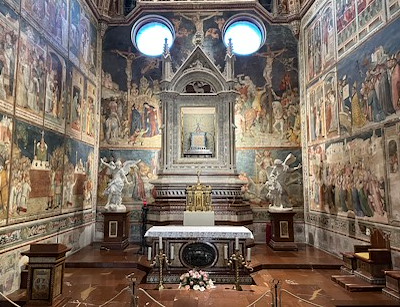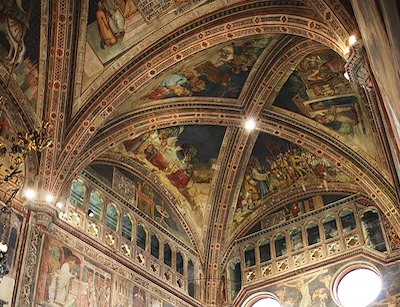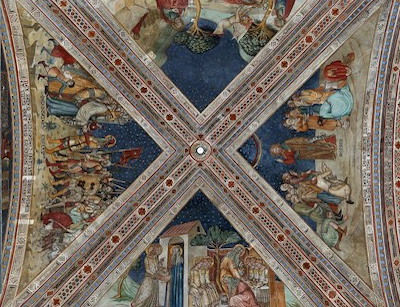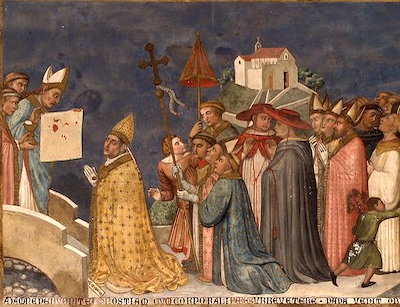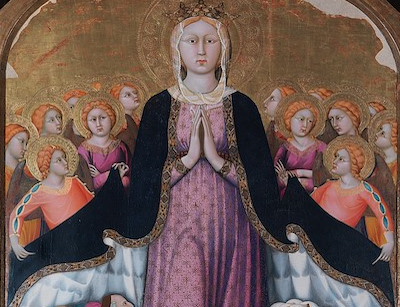The Chapel of the Corporal
Built in the mid-14th century, this chapel owes its name to the relic of the Sacred Altar Linen of the Miracle of Bolsena preserved here.
-
In 1263, a Bohemian priest was celebrating mass in Bolsena when the communion bread started to bleed onto the corporal. When Pope Urban IV learned about this miracle, he had the Sacred Altar Linen moved to Orvieto, where he established the feast of Corpus Christi by the Transiturus bull.
-
Orvieto commemorates the Miracle of Bolsena and the feast of Corpus Christi every year with the procession of the Sacred Corporal accompanied by a parade in medieval costumes.

Built in the mid-14th century, this chapel owes its name to the relic of the Sacred Altar Linen – the Corporal – of the Miracle of Bolsena preserved here. The walls were frescoed by Ugolino di Prete Ilario in collaboration with several other artists, including Giovanni Buccio Leonardelli, Petrucciolo di Marco, Domenico di Meo, Piero di Puccio, and Antonio di Andreuccio. Each section has an inscription explaining what’s depicted in it. Episodes of the Miracle of Bolsena are shown on the right wall, while Eucharistic miracles are on the left wall. Above the arch at the chapel’s entrance is a depiction of the Last Supper in which Judas appears as a demon.
Fun facts:
- It is said that a Bohemian priest – Peter of Prague – had doubts about transubstantiation, i.e., that during consecration, the communion bread became the Body of Christ. In 1263, Peter stopped in Bolsena on his pilgrimage to Rome. He was celebrating Mass in the church of Santa Cristina when drops of blood started falling from the communion bread he was holding, staining the corporal, i.e., the altar linen used during the Mass. When Pope Urban IV learned about this miracle, he had the Sacred Altar Linen moved to Orvieto, where he was at the time and where he established the feast of Corpus Christi by the Transiturus bull in 1264.
- Orvieto commemorates the Miracle of Bolsena and the feast of Corpus Christi every year with the procession of the Blessed Sacrament and the Sacred Corporal. This procession is accompanied by a parade in medieval costumes, where the magistracies of the medieval communes and the coat of arms of the local noble families are represented.
The vault
The vault was partly decorated by Giacomo da Bologna with golden stars on a blue background. It is divided into eight spandrels depicting prophecies and Eucharistic symbols. The lunettes under the vaults depict pairs of angels and the crests of the Opera del Duomo.
The Tabernacle by Orcagna
Located behind the altar, it houses the Sacred Linen of the Miracle of Bolsena. This gothic tabernacle was designed by Niccolò da Siena and made by Andrea di Cione, also known as Orcagna, in the mid-14th century. It is made of red and white marble and decorated with mosaics. Initially, the Corporal was preserved in a 1338 reliquary by Ugolino di Vieri, which can now be seen in the Libreria Albèri in the Opera del Duomo Museum.
Our Lady of the Recommended

The early 14th-century panel on the right wall of the Chapel of the Corporal depicts Our Lady of Mercy – also known as Our Lady of the Recommended – surrounded by angels as she wraps men and women in her mantle to protect them.
Image gallery
Admission method
The Chapel of the Corporal can be accessed for free, but only for praying, every day during the Duomo’s opening hours. Access is not permitted during religious functions celebrated at the main altar of the Basilica.
The entrance is on the left side of the Cathedral, facing the façade.
EXPOSITION OF THE SACRED CORPORAL
For preservation reasons, the Bishop has established that the Relic of the Sacred Corporate is to be exposed only during the following periods:
- from Christmas morning to Epiphany evening
- from Easter morning to Pentecost evening
- Corpus Christi day
- Assumption day

 ITA
ITA

